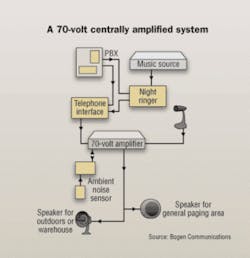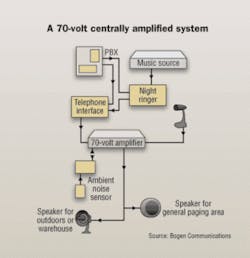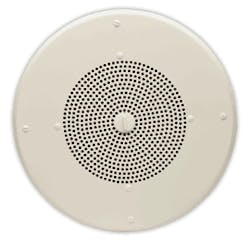Choosing the right paging and alert system
Why you need to understand the differences between 70-volt and 24-volt system design.
If you’re entering the world of paging and alert system installations, you’ll need to understand the differences between 70-volt and 24-volt self-amplified systems, and why one system may be better suited for a given environment.
Given a particular installation setting, each system presents advantages and disadvantages. Both provide the same basic paging functionality in either a large or small enterprise end-user environment, but you’ll need to be more conscious of what cabling conditions are required when preparing for the installation-including the type of system being installed, as well as the features it will provide the customers.
It can be well worth the investment in time to learn the ins and outs of paging and alert installations, because these systems can provide an added source of revenue. “The primary reason for contractors to become involved in the paging market is sales revenue,” says Linda Bishop, advertising manager for Valcom Inc. (www.valcom.com), which manufactures 24-volt systems. “It’s a natural fit and a profitable peripheral.”
Bishop adds,“A paging system job is typically 50% installation cost and 50% hardware. Who better to sell paging systems than cabling contractors?”
Background tunes and back-door security
An intercom paging system in a commercial building is often called an overhead voice paging system. These are typically accessed from telephone sets, either while or without being connected to a PBX telephone system. Remote paging systems, meanwhile, are accessed from central office lines.
Paging control units offer a multitude of features, such as emergency overhead paging, background music, all-call, and door entry/security. They also provide convenient user access to the paging system via any telephone in the facility. Employees can make a voice page by dialing a code or pressing a button before making an announcement.
Many enterprise end users are required by government authorities to have systems in place specifically for emergency and safety announcements. In addition to an emergency/life safety system, the building paging system is often used for emergency announcements as well as other routine announcements.
Stop and start work tones, background music and personnel tracking are now all considered to be common uses of a building public address or paging system. Zoned paging and announcements within a building can be used to improve productivity, increase staff efficiency and reduce telephone bills and customer hold times.
“From a consumer level, end users see it as a huge convenience factor,” says Jim Livingston, vice president of wireless paging system installer Long Range Systems Inc. (www.pager.net). “That’s what we do. We create efficiency and productivity.”
Voice paging equipment is connected to a building’s speaker distribution system. Speakers may be flush-mounted in the ceiling, suspended from the ceiling, or wall-mounted. Horns are often mounted on walls, racks, poles, I-beams, or suspended from ceilings in warehouses, manufacturing facilities, or outdoor applications.
There are numerous options for installing speakers in ceilings and walls:
• Lay-in ceiling speaker assemblies offer easy installation in ceiling grid work. They are designed for use with standard two-foot-wide ceiling tiles and distribute the weight of the speaker assembly across the tile and onto the tile support grid.
• Round speaker baffles can be cut into ceiling tiles and plaster works to provide a clean flush installation.
• Ceiling speaker bridges provide support to prevent ceiling tile from sagging from the weight of the speaker.
• Ceiling speaker back-boxes provide an acoustic enclosure behind the speaker for better sound quality. They also protect the speaker from debris in the ceiling and meet most local fire codes for use in air plenum return ceilings.
• Wall-mounted surface speakers and track-style mounting options support applications in open spaces and wide areas where there are no ceilings. Quality of sound varies from speaker to speaker and from one manufacturer to another. Typically, speakers with larger back boxes reproduce music better.
In larger buildings or multi-building campus applications, there may be multiple zones for the paging system. Audio paging cable runs typically return to the nearest telecommunications room or equipment room, which allows for easier maintenance, troubleshooting, and system changes. But it also means coordinating space, power, air conditioning and cable routing for the overhead intercom and voice paging system.
The 70 vs. 24 difference
The two main technologies employed in voice paging systems are 70-volt centrally amplified and 24-volt distributed amplified systems. With both systems, the voice page may be accessed by a microphone or by a telephone. The voice signal is amplified and broadcast over the speakers and/or horns. Wireless paging systems are primarily used between moving objects, such as large hangar doors, overhead cranes, forklifts and occasionally between buildings.
Gary Christiansen, president of contracting company CAI Electronics (www.caielectronics.ciom), says both systems have advantages, and it is up to the contractor to determine which will work best in a given setting. His team, for example, recently chose a 70-volt system to be installed in a frozen food warehouse where the highest temperature was -20°. They chose the 70-volt system because a self-amplified speaker would have had difficulty working at such a low temperature.
“They couldn’t tell us what noise factor fans would have on that thing,” says Christiansen. “You find that powered amplifiers at 30 below, unless they are rated to work that way, will not work. Even the impedance will change with that temperature. This is one situation where it would only make sense to use a 70-volt system,” Christiansen continues.
When approaching a paging system installation, it’s important to consider the system that would be more economical to install as well as what would make sense for a given installation. “A good designer needs to look at the systems’ needs, and decide what would be more expedient and efficient to put in,” says David Chambers, senior vice president of sales for Bogen Communications Inc. (www.bogen.com), a manufacturer of both 70-volt and 24-volt systems.
First things first
But before installing a paging and alert system, it’s important to first conduct a site survey. You’ll need to determine the required speaker size, the size of the area that must be covered by the speakers, the spacing of those speakers, and how many amplifiers will be needed. Design from “inside out.” In other words, start the design from the equipment room and bring it to the area where the farthest speaker will be placed.
Valcom can take the blueprints of the building in which you plan to install the system and will make a recommended design, showing a plot system that indicates where to install speakers and horns. Bogen Communications provides computer-aided design (CAD) drawings of speaker placement, and will help provide design information based on blueprints.
The 24-volt self-amplified technology matches each paging speaker with its own amplifier and built-in volume control, which essentially makes each speaker its own independent public address system. This self-amplified technology eliminates the need for expensive 70-volt central amplifiers. On the lower end of the scale, a 15-watt 70-volt central amplifier, for example, costs about $158. By comparison, a 15-watt self-amplified speaker costs about $70. The self-amplified products contain four terminals: two provide power to the amplifier, and two are voice pairs used to carry the voice signal.
Speakers in 70-volt systems are centrally amplified. When installing, you’ll need to make connections using 600-Ώ lines and speaker lines to bring power to the amplifier. A centrally amplified system requires only about half as many cable connections as that of a 24-volt system-important to remember when pricing out a job based on the number of connections that will be needed.
With 24-volt systems, power and audio are carried to the electronics in the speakers through Category 5 or other cabling. The cabling has four pairs of wires: one for audio and one for power. The pairs are connected to the speakers’ two voice input terminals and two power terminals, which allows for amplification. Using the telephone line level, you can make each speaker independently adjustable so that end-users can adjust the volume at each individual speaker point. Speakers are networked together using standard telephone/datacom low-voltage wiring.
“It’s a way of matrixing a sound system, allowing you flexibility,” says Christiansen.
Other 24-V plusses and minuses
If the central amplifier fails in a 70-volt centrally amplified system, the entire paging system will fail. But with a 24-volt self-amplified system, the potential for total system failure is eliminated due to inherent redundancy and its immediate fault isolation capability.
The 24-volt systems are also less labor-intensive and more cost-effective because they utilize existing cables, including categories 3, 5 and 6. End users can capitalize on their existing infrastructure by installing the overhead loudspeaker paging system on the already in-place wiring, resulting in significant cost/labor savings.
These systems do not require special wiring or conduit, as is needed with traditional 70-volt systems that utilize high-voltage signals. In addition, 24-volt systems allow system flexibility, such as offering virtually unlimited system expansion, and simplify moves, adds and changes.
“You can use structured cabling that is already in place, eliminating a tremendous amount of installation time and effort,” says Bishop.
But while they may be less labor intensive, 24-volt systems have one inherent disadvantage: Their complexity considerably lowers the meantime before failure.
“The minute you add more complexity to the speakers, you increase their failure points,” Christiansen says.
Also, 24-volt, self-amplified speakers are costly, and so should be limited to smaller business or office settings. A 70-volt system is more appropriate for a larger industrial setting. A self-amplified speaker, for example, may cost $27, so six of them would cost approximately $162. By comparison, a 70-volt speaker may cost about half as much-around $15.
As a rule of thumb, a small number of speakers often work better with a self-amplified product. Self-amplified ceiling systems make more sense, for instance, when installing a system in a small office setting.
“The self-amplified systems are expensive, and you have to send power to each speaker,” says Michael Sandman, vice president of Mike Sandman Enterprises, (www.sandman.com), whose company installs paging systems. “If you hang 10 at a business, that is doable. But for a large plant, that would be insane.”
“Given all things what they are, if you have just a few speakers in your paging system, then self-amplified would be cheaper,” agrees Chambers. But as the settings become larger, such as industrial, a centrally-amplified solution becomes more economical. These larger areas require more speakers that are mounted on walls or stands.
Finally, if choosing a 70-volt system, beware of other nearby cables that can cause interference. “If 70-volt speaker cables are adjacent to telephone cabling, bleed through and crosstalk can occur, in rare cases,” cautions Chambers.
BRIAN MILLIGAN is senior editor for Cabling Installation & Maintenance.



